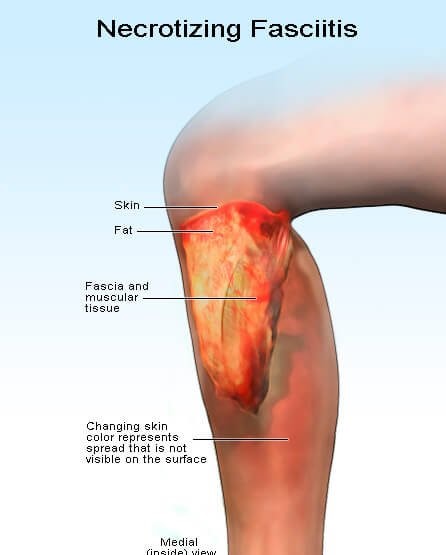
NECROTISING FASCIITIS
- March 14, 2024
- Posted by Dr. Vaidya Karanvir Singh
- 0 Comment(s)
INTRODUCTION
- Necrotizing fasciitis is referred to as a flesh- eating bacterial infection.
- A serious bacterial infection that destroys skin , fat and the soft tissues covering muscles (fascia).
- This condition can occur anywhere in the body but most commonly affects the extremities , perineal area, and abdominal wall.
Types
- Type 1 necrotising fasciitis
Bacteria causing type 1 necrotising fasciitis include staphylococcus aureus , vibrio , haemophilus etc. This type is more common in individuals with underlying health conditions such as diabetes or other conditions.
- Type 2 necrotising fasciitis : Monomicrobial infection usually caused by group A streptococcus (GAS), also known as streptococcus pyogenes.
- Vibrio vulnificus : A specific type of necrotizing fasciitis caused by bacterium vibrio vulnificus . Infection can occur through open wounds exposed to contaminated water or by consuming raw or undercooked seafood containing the bacteria.
CAUSES
Necrotizing fasciitis is typically caused by a bacterial infection most commonly by group A streptococcus (GAS) bacteria. Other bacteria such as clostridium , vibrio vulnificus and staphylococcus aureus can cause the condition.
These bacteria can enter the body through breaks in the skin such as cuts, scrapes , burns , insect bites or surgical wounds and rapidly spread through the deep layers of tissue releasing toxins that damage and kill tissue.
Symptoms of necrotising fasciitis
The symptoms of necrotizing fasciitis depending on the type of bacteria causing the infection and the site of the infection.
Common symptoms include:
- Severe pain in the affected area .
- Redness , swelling and warmth in the affected area.
- Fever , chills and fatigue.
- Blisters , ulcers or black spots on the skin.
- Nausea , vomiting and diarrhea.
- Low blood pressure
- Confusion , dizziness
Risks for necrotising fasciitis include :
- Aspirin and non-steroidal anti-inflammatory drugs
- Weakened immune system
- Chronic illnesses
- Surgery or trauma
- Obesity
COMPLICATIONS
- Scars
- Sepsis
- Toxic shock syndroms
- Loss of limbs (arms , legs , fingers)
- Death
PREVENTION
- Keep your hands clean
- Try to avoid cuts, burns, scratches .
- Clean wound with soap and water and then cover it with a clean bandage till it heals.
- Don’t go into swimming pools , hot tubs if you have a break in your skin.
TREATMENT OF NECROTISING FASCIITIS
Treatment usually includes:
- Antibiotics
- Surgery to remove the affected area
ACCORDING TO AYURVEDA
In ayurveda , necrotizing fasciitis would classified as a type of severe skin disorder or kushtha .
- Ayurvedic treatments for skin disorders focus on balancing the Dosha’s (vata , pitta and kapha) .
- Ayurvedic therapies like Panchakarma (detoxification and rejuvenation treatment ) help to cleanse the body and support healing.
Herbal Remedies
- Turmeric (curcuma longa)
Turmeric known for its anti-inflammatory and antimicrobial properties. Used to support wound healing and reduce inflammation.
- Neem (azadirachta indica)
Neem has antibacterial , antifungal and antiviral properties and is used in traditional medicine for skin disorders and infections.
- Aloe vera
Aloe vera has soothing and healing properties and is often used topically for burns , wounds and skin infections.
- Garlic (allium sativum)
Garlic has antimicrobial properties
- Echinacea (echinacea purpurea)
Echinacea have immune-boosting properties and help the body to fight infections.
DIETARY RECOMMENDATIONS
- Warm , cooked foods that are easy to digest.
- Avoid raw foods that may aggravate vata dosha.
- Include digestive spices such as ginger , cumin , coriander and turmeric in meal.
- Healthy fats such as ghee , coconut oil and olive oil in moderation .
- Drink plenty of warm water to stay hydrated and support detoxification.
- Avoid processed foods
- Ayurvedic herbal teas made from immune-boosting herbs such as tulsi ,ginger and licorice root.

Dr. Vaidya Karanvir Singh is the younger Vaidya in Chandigarh Ayurved & Panchakarma Centre. He is the fourth generation in his family who is practicing as a general consultant in Ayurved & Panchakarma treatment at Chandigarh. In his practice, he had treated more than 1 Lakh Plus patients worldwide.

